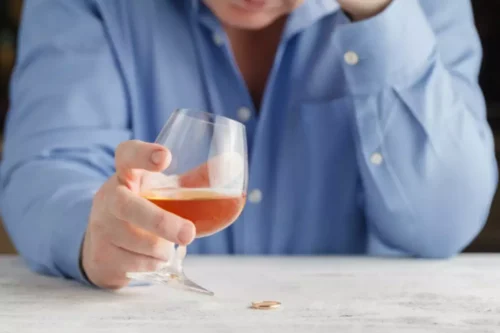
Dopamine is a neuromodulating compound that is released in the ventral tegmental area (VTA) and projects to the nucleus accumbens (NA) where it is acutely involved in motivation and reinforcement behaviours. A huge risk factor for people who develop alcohol use disorder is early-onset drinking. So, if you drink before the age of 14, there’s about a 50% chance you’re going to develop an alcohol use disorder in your adulthood,” explains Dr. Anand. “Generally, over time, there have been new studies that show that chronic alcohol use — at very heavy use — can lead to brain damage, both gray and white matter.

Ethanol and a rapid-acting antidepressant produce overlapping changes in exon expression in the synaptic transcriptome
A study conducted by[39] to assess the association of Taq1A polymorphism and AD in south Indian population yielded negative results.[40,41] also did not find any association with Taq1A polymorphism and AD amongst Mexican-Americans. The Taq1A allele frequency of non-assessed controls was more than that of non-assessed alcoholics. However, the allele frequency of assessed alcoholics was found to be 3 times that of assessed controls.

Influence of alcohol consumption on the dopaminergic system
The fourth pathway which interests us and is of note for alcohol addiction is the pathway of glutamate. There have been some studies conducted into the involvement of this pathway in the process of alcohol addiction. According to one study published by[67] physical dependence, which refers to the pharmacological tolerance induced by chronic alcohol intake, results in AWS and is neurobiologically supported by the imbalance between GABA and glutamate-NMDA neurotransmission. Lastly, new tools, like the fly TransTimer,144 are providing a means in which to study the real-time spatiotemporal dynamics of gene expression. TransTimer is a method that uses 2 fast-folding fluorescent proteins, where one has a shorter half-life (ie, a destabilized GFP) and the other has a longer half-life (ie, a stable RFP).
Alcohol and Dopamine Addiction
However, species differences in cannabinoid receptor expression and distribution, particularly in the VTA, may underlie differences in the rewarding effects of THC between humans, non-human primates and rodents [144]. Here we quantified AB toward alcohol and non-drug, https://ecosoberhouse.com/ reward-conditioned cues and their neural underpinnings after acute dopamine precursor depletion across a broad spectrum of alcohol users. P/T depletion significantly reduced AB across three different tasks, particularly in individuals who reported heavier drinking.
- Advances in neuroscience continue to shed light onto regulatory mechanisms relevant for alcohol use.
- The study by[42] found conflicting results for male and female subjects, with female subjects showing AD only on the basis of alcohol disorder.[44] In their study of alcohol-dependence in Polish population reported negative association between Taq1A allele and AD.
- These complex and highly interlinked pathways activate specific gene expression programs, which underlie neuronal maladaptations and contribute to the development of alcohol use disorder.
- Similarly, another study conducted by[66] found no association between the genes encoding GABRA1 and GABRA6 with alcoholism.
- It is the first choice in the long list of things which can make a person feel intoxicated and give that feeling of high.
- The role of dopamine in AUD is complex and has been reviewed in detail elsewhere [10,11,12,13].
- The brain mediates our motivation to repeat behaviors that lead to pleasurable, rewarding states or reduce uncomfortable, distressing physical or emotional states.
- Motivational arousal varies over time and, in resting animals, determines when a previously sated animal starts to become hungry and interested in seeking food.
- Alcohol can disrupt fetal development at any stage during a pregnancy—including at the earliest stages and before a woman knows she is pregnant.
- Countless human and rodent studies have explored the relationship between the dopaminergic signaling and alcohol abuse with evidence amassed from anatomical, physiological, pharmacologic, genetic, and behavioral research.
- We examined the behavioral evidence for overlapping mechanisms of alcohol and non-drug reward AB by conducting pairwise Spearman’s partial correlations among the three AB tasks, covarying for beverage effects.
Recently, two sub types of the GABAA receptor have come into the spotlight for showing what can possibly be a genetic predisposition to alcohol addiction. These two subtypes are namely GABA A receptor α1 (GABRA1) and GABA A receptor α6 (GABRA6). The gene encoding GABRA1 is located on chromosome 5 at 5q34-35 while the gene encoding GABRA6 is located on the same chromosome at 5q34. According to a study by,[62] a significant correlation was found with the GABRA1 genotype and Collaborative Study of the Genetics of Alcoholism (COGA) AD, history of blackouts, age at first drunkenness as well as the level of response to alcohol. The study concludes by stating that the efforts to characterize genetic contributions to AD may benefit by examining alcohol-related behaviors in addition to clinical AD. Apart from the dopamine pathways, the addiction to alcohol has also been suggested through the serotonin pathways.
Together, the studies reviewed earlier illustrate the complexity of AUD, which results from the interaction of the various levels of molecular neuroadaptations in different brain regions and neural circuit changes throughout the brain [127]. The specific molecular pathways and circuits that could serve as the most promising therapeutic targets remain to be delineated (see Outstanding Questions). Finally, the development of cutting-edge tools for neurotransmitter sensing, circuitry mapping and manipulation on a more precise spatial and temporal scale will enable further advances in our understanding of how neural activity and communication are altered by chronic alcohol use to produce excessive drinking behaviors. Burst-firing of the dopamine system is only a first step in the learning; the formation of the synapses for searching develops in other cellular elements. Dopamine bursting enables development of long-term potentiation (LTP) and long-term depression (LTD), and, in the striatum, this occurs between glutamatergic sensory inputs and GABAergic motor-related outputs [45, 46]. Dopamine in the striatum reaches and binds to high-affinity D2 dopamine receptors and low-affinity D1 receptors [48, 49].
A better understanding of how alcohol affects these diverse and interlinked mechanisms may lead to the identification of novel therapeutic targets and to the development of much-needed novel and efficacious treatment options. It influences intracellular signaling mechanisms, leading to changes in gene expression, chromatin remodeling and translation. Together, these mechanisms produce long-lasting cellular adaptations in the brain that in turn can drive the development and maintenance of alcohol use disorder.

In addition, one of the latest studies on this pathway found an association between a polymorphism in the promoter of a glutamate receptor subunit gene and alcoholism. The study was conducted by[68] and the study found that short alleles were significantly less frequent among AD subjects. The study concludes by stating that it was the 1st time that such an association was found with the stated polymorphism and AD. Another study by[55] aimed to look at the availability of the SERT in patients with AD. SERT availability was measured in vivo with single photon emission computed tomography and (123) I-labeled 2-((2-((dimethyl-amino) methyl) phenyl) thio)-5-iodophenylamine in the midbrain, thalamus and striatum. The study found that when compared with healthy controls, patients with pure AD had a significantly lower availability of SERT in the midbrain.
These alkaloid compounds have been suggested to be responsible for the physiological effects of alcohol as well as the manifestation of the behavioural aspects of alcohol-related disorders. Acetaldehyde is a highly reactive compound that reacts with several catecholamines (i.e. dopamine and serotonin) in the brain. Opioid systems involving endogenous opioids (endorphins, enkephalins and dynorphins) influence drinking behaviour via interaction with the mesolimbic system.

Researchers are still trying to understand the many complex factors that influence addictions to substances and behaviors. This feel-good hormone can motivate you to seek out pleasurable experiences, so being aware of your behaviors alcohol and dopamine can help you recognize signs that you might be developing an problem. Becoming dependent on that rush of dopamine can be risky when it involves behaviors or substances that pose dangers to our physical and mental health.
